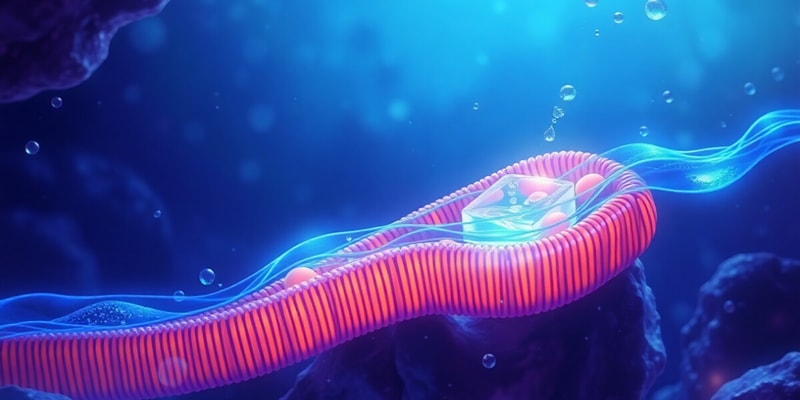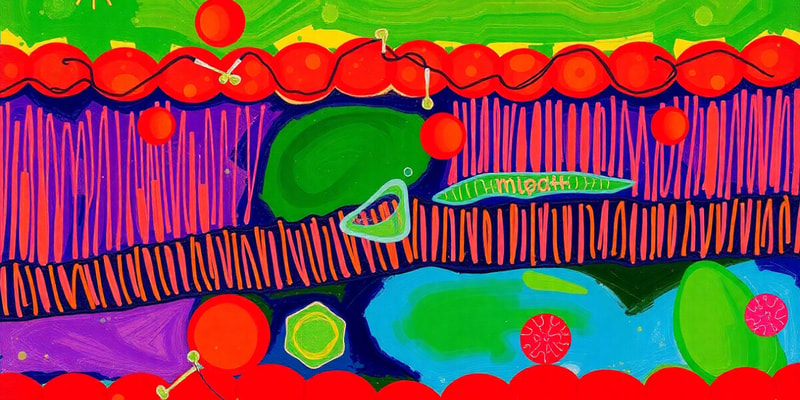Podcast
Questions and Answers
The Na+/glucose co-transporter allows Na+ to exit the cell and glucose to enter the lumen.
The Na+/glucose co-transporter allows Na+ to exit the cell and glucose to enter the lumen.
False
Water is absorbed in the gut primarily through regulated absorption mechanisms.
Water is absorbed in the gut primarily through regulated absorption mechanisms.
False
Aquaporins (AQPs) play a vital role in water reabsorption in the kidney collecting duct.
Aquaporins (AQPs) play a vital role in water reabsorption in the kidney collecting duct.
True
Under conditions of high ADH levels, AQP-2 is present on the surface of epithelial cells in the kidney collecting duct.
Under conditions of high ADH levels, AQP-2 is present on the surface of epithelial cells in the kidney collecting duct.
Signup and view all the answers
Leaky tight junctions are impermeable to water in both the gut and kidney tubules.
Leaky tight junctions are impermeable to water in both the gut and kidney tubules.
Signup and view all the answers
The primary effect of Na+ and glucose entering the cell is to create a hyperosmotic environment in the interstitial space.
The primary effect of Na+ and glucose entering the cell is to create a hyperosmotic environment in the interstitial space.
Signup and view all the answers
In a well-hydrated state, the levels of ADH are high, allowing significant water reabsorption in the collecting duct.
In a well-hydrated state, the levels of ADH are high, allowing significant water reabsorption in the collecting duct.
Signup and view all the answers
Regulated absorption of water occurs primarily through the paracellular pathway.
Regulated absorption of water occurs primarily through the paracellular pathway.
Signup and view all the answers
The Na+ pump on the basolateral membrane keeps ICF [Na+] high to facilitate glucose transport.
The Na+ pump on the basolateral membrane keeps ICF [Na+] high to facilitate glucose transport.
Signup and view all the answers
The concentration of glucose is higher in the epithelial cells than in the lumen of the intestine.
The concentration of glucose is higher in the epithelial cells than in the lumen of the intestine.
Signup and view all the answers
Na+/Glu symporters situated on the apical membrane allow glucose to enter the cells with no energy input.
Na+/Glu symporters situated on the apical membrane allow glucose to enter the cells with no energy input.
Signup and view all the answers
The interstitial space has a high concentration of sodium ions.
The interstitial space has a high concentration of sodium ions.
Signup and view all the answers
Active transport is required for glucose to cross the basal membrane against its concentration gradient.
Active transport is required for glucose to cross the basal membrane against its concentration gradient.
Signup and view all the answers
Glucose concentration in the lumen of the intestine is higher than in the epithelial cells.
Glucose concentration in the lumen of the intestine is higher than in the epithelial cells.
Signup and view all the answers
Na+ channels are present on the apical membrane for sodium ions to enter the epithelial cells.
Na+ channels are present on the apical membrane for sodium ions to enter the epithelial cells.
Signup and view all the answers
The presence of a low intracellular sodium concentration aids in the entry of sodium from the lumen.
The presence of a low intracellular sodium concentration aids in the entry of sodium from the lumen.
Signup and view all the answers
Glucose in the interstitial space is at a higher concentration than in the epithelial cells.
Glucose in the interstitial space is at a higher concentration than in the epithelial cells.
Signup and view all the answers
The Na/Glu symporter operates via primary active transport.
The Na/Glu symporter operates via primary active transport.
Signup and view all the answers
Sodium ions enter the epithelial cells via the Na+/Glu symporters against their concentration gradient.
Sodium ions enter the epithelial cells via the Na+/Glu symporters against their concentration gradient.
Signup and view all the answers
The glucose uniporter facilitates the movement of glucose from the lumen into epithelial cells.
The glucose uniporter facilitates the movement of glucose from the lumen into epithelial cells.
Signup and view all the answers
Sodium concentration is higher in the interstitial space compared to the epithelial cells.
Sodium concentration is higher in the interstitial space compared to the epithelial cells.
Signup and view all the answers
The sodium pump is located on the apical membrane of the epithelial cells.
The sodium pump is located on the apical membrane of the epithelial cells.
Signup and view all the answers
A sodium concentration gradient is established due to 1˚ active transport.
A sodium concentration gradient is established due to 1˚ active transport.
Signup and view all the answers
Glucose moves from the lumen into epithelial cells against its concentration gradient.
Glucose moves from the lumen into epithelial cells against its concentration gradient.
Signup and view all the answers
Folate is absorbed in the intestine through a sodium/folate transporter.
Folate is absorbed in the intestine through a sodium/folate transporter.
Signup and view all the answers
The mechanism for glucose leaving the cells into the blood involves facilitated diffusion.
The mechanism for glucose leaving the cells into the blood involves facilitated diffusion.
Signup and view all the answers
The Na/Glu symporter is found on the basolateral membrane of the epithelial cells.
The Na/Glu symporter is found on the basolateral membrane of the epithelial cells.
Signup and view all the answers
Amino acids are absorbed via Na/amino acid transporters in a similar manner to glucose.
Amino acids are absorbed via Na/amino acid transporters in a similar manner to glucose.
Signup and view all the answers
The Na+ pump primarily works by absorbing Na+ through the apical membrane.
The Na+ pump primarily works by absorbing Na+ through the apical membrane.
Signup and view all the answers
Osmosis involves the flow of water (H2O) across a membrane from an area of low solute concentration to an area of high solute concentration.
Osmosis involves the flow of water (H2O) across a membrane from an area of low solute concentration to an area of high solute concentration.
Signup and view all the answers
The Na/Glu symporter in the intestinal lumen allows Na+ and glucose to enter epithelial cells simultaneously.
The Na/Glu symporter in the intestinal lumen allows Na+ and glucose to enter epithelial cells simultaneously.
Signup and view all the answers
The tight junctions between epithelial cells increase the permeability of Na+ across the intestinal membrane.
The tight junctions between epithelial cells increase the permeability of Na+ across the intestinal membrane.
Signup and view all the answers
Na+ channels are necessary for Na+ to be transported across the apical membrane.
Na+ channels are necessary for Na+ to be transported across the apical membrane.
Signup and view all the answers
Water flows up its concentration gradient during osmotic gradient conditions.
Water flows up its concentration gradient during osmotic gradient conditions.
Signup and view all the answers
The Na+/Glucose cotransporter is responsible for the bulk uptake of sodium in the gut.
The Na+/Glucose cotransporter is responsible for the bulk uptake of sodium in the gut.
Signup and view all the answers
Tight junctions in the small intestine and kidneys are completely impermeable to water.
Tight junctions in the small intestine and kidneys are completely impermeable to water.
Signup and view all the answers
Absorption of water in healthy individuals is a regulated process.
Absorption of water in healthy individuals is a regulated process.
Signup and view all the answers
The absorption of large volumes of water from the lumen to interstitial fluid primarily occurs via the transcellular pathway.
The absorption of large volumes of water from the lumen to interstitial fluid primarily occurs via the transcellular pathway.
Signup and view all the answers
Osmotic gradients are important for facilitating the movement of water across cell membranes.
Osmotic gradients are important for facilitating the movement of water across cell membranes.
Signup and view all the answers
The biggest medical breakthrough of the 20th century is related to glucose metabolism.
The biggest medical breakthrough of the 20th century is related to glucose metabolism.
Signup and view all the answers
Water reabsorption occurs only in the small intestine.
Water reabsorption occurs only in the small intestine.
Signup and view all the answers
Healthy individuals typically do not have an osmotic gradient in their intestines.
Healthy individuals typically do not have an osmotic gradient in their intestines.
Signup and view all the answers
The bulk intake of water is a passive process dependent on osmotic gradients.
The bulk intake of water is a passive process dependent on osmotic gradients.
Signup and view all the answers
Study Notes
Glucose Transport
- The sodium-glucose cotransporter (SGLT) transports glucose from the lumen of the gut into epithelial cells.
- SGLT uses the energy from the sodium concentration gradient to move glucose against its concentration gradient.
- Glucose moves from the epithelial cells into the interstitial space via a glucose uniporter on the basolateral membrane.
- The movement of sodium and glucose from the lumen into epithelial cells contributes to an osmotic gradient.
Bulk Absorption of Water
- Bulk absorption refers to the absorption of large volumes of water from the lumen of the gut or kidney tubules into the interstitial fluid.
- The movement of water is primarily via the paracellular pathway, where water moves between epithelial cells through the so-called "leaky" tight junctions.
Regulated Absorption of Water
- Regulated absorption of water involves the movement of small volumes of water across epithelial cells in the kidney collecting duct.
- This occurs via the transcellular pathway, where water moves through epithelial cells through aquaporins.
- The tight junctions between the cells in the collecting duct are impermeable to water.
- Antidiuretic hormone (ADH) regulates the water permeability of the collecting duct by promoting the insertion of aquaporin-2 (AQP-2) channels into the apical membrane of the collecting duct epithelial cells.
Sodium Gradient and Glucose Uptake
- The sodium-potassium pump (Na+/K+ ATPase) maintains a low intracellular sodium concentration ([Na+]i) and a high extracellular sodium concentration ([Na+]o).
- The sodium gradient provides the energy for the SGLT to move glucose from the lumen into the epithelial cells.
Bulk Absorption in the Gut
- The bulk absorption of water in the gut relies on the osmotic gradient created by the movement of sodium and glucose.
- The "leakiness" of tight junctions in the gut allows for the movement of water from the lumen to the interstitial space.
- The movement of sodium and glucose from the lumen into epithelial cells increases the osmolarity in the interstitial space, which drives water movement across the "leaky" tight junctions.
- This absorption of water is a constitutive process in healthy individuals, meaning it occurs continuously without the need for regulation.
Role of the Sodium Pump
- The sodium pump plays a vital role in the bulk absorption of water by maintaining the sodium gradient.
- By pumping sodium out of the epithelial cells and into the interstitial space, the pump ensures the continued movement of water from the lumen into the interstitial space.
Studying That Suits You
Use AI to generate personalized quizzes and flashcards to suit your learning preferences.
Related Documents
Description
This quiz evaluates your understanding of the mechanisms of glucose transport and water absorption in the human body. It covers topics such as the sodium-glucose cotransporter, bulk absorption of water, and the regulated absorption processes in the kidneys. Test your knowledge of these essential physiological processes.



